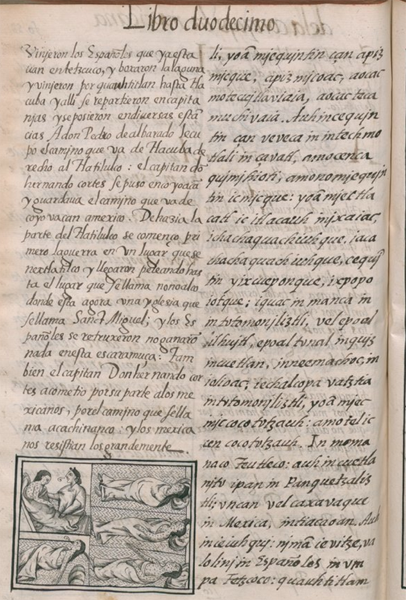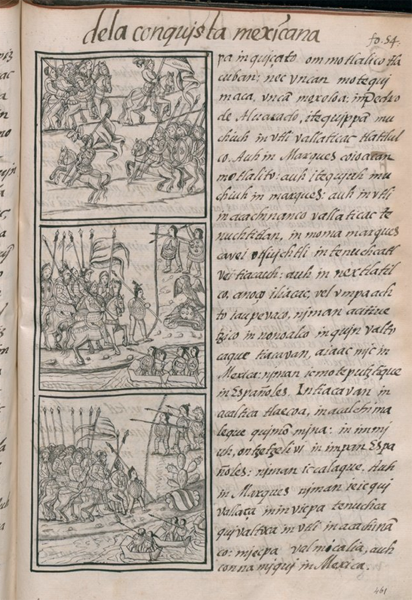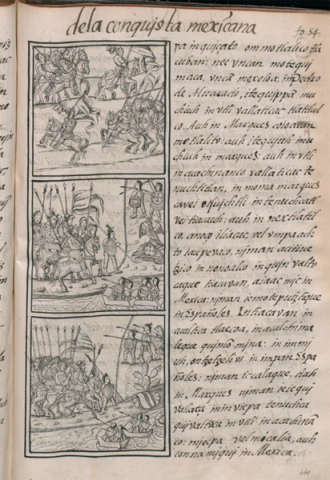 |
[Transcription of the Nahuatl (right-hand column) by James Lockhart:]
[f. 53r.] Inic cempoalli onchicunavi capitulo: uncan mitoa in quenin valla Totomoniztli, inic micque nicā tlaca: in itoca vei çavatl, in iquac oquizque Españoles in Mexico.
Auh in aiamo totech moquetza in Españoles: achtopamomanaco vei cocoliztli, totomonaliztli, ipan tepeilhuitlin tzintic, in tetech motecac vevei tepopul: cequi velpepechtic, novian in motecac in teixco, in teicpac, inteelpan .&. vellaixpolo, vel miequintin ic micque, aocvel nenemia, ça onoca in imonoian in incuchian, aoc vel moliniaia, aoc vel mocuechiniaia, aoc vel mocuecuetzoaia, aoc vel monacacicteca, aoc vel mixtlapachtecaia, aoc vel maquetztitecaia. Auh in iquac mocuechiniaia, cenca tzatzia: cenca tlaixpolo, in pepechtic, in pepechiuhqui in çaoatl, vel miec tlacatl, ic momiqui
|
[Translation of the Nahuatl (right-hand column) by James Lockhart:]
Twenty-ninth chapter, where it is said how, at the time when the Spaniards left Mexico, there came an illness of pustules of which many local people died; it was called “the great rash” [smallpox].
Before the Spaniards appeared to us, first an epidemic broke out, a sickness of pustules. It began in Tepeilhuitl. Large bumps spread on people; some were entirely covered. They spread everywhere, on the face, the head, the chest, etc. [The disease] brought great desolation; a great many died of it. They could no longer walk about, but lay in their dwellings and sleeping places, no longer able to move or stir. They were unable to change position, to stretch out on their sides or face down, or raise their heads. And when they made a motion, they called out loudly. The pustules that covered people caused great desolation; very many people died of them,
[Translation of the Spanish (left-hand column) by James Lockhart:]
Chapter Twenty-nine, of the pestilence of smallpox that broke out among the Indians after the Spaniards left Mexico.
Before the Spaniards who were in Tlaxcala came to conquer Mexico, a pestilence of smallpox struck among all the Indians in the month they called Tepeilhuitl, which is at the end of September. Very many Indians died of this pestilence; they had their whole bodies, faces, and limbs so full of pocks and damaged by them that they could not stir, or move out of their place, or turn from one side to the other. If someone moved them, they would cry out. This pestilence killed innumerable people. Many died of hunger, because there was no one who could prepare food.
Those who escaped from this pestilence were left with their faces pitted, and some lost eyes.
The force of this pestilence lasted sixty days, and when it began to slacken off in Mexico, it went toward Chalco.
When this pestilence was ending in Mexico,
|
[Translation of the Nahuatl into Spanish by Fr. Bernardino de Sahagún; transcription of the Spanish (left-hand column) by James Lockhart:]
[f. 53r.] Capitulo .29. de la pestilencia que vino sobre los yndios de viruelas despues que los españoles salieron de mexico.
Ante que los españoles que estauan en Tlaxcalla viniesen a conquistar a mexico dio vna pestilencia de viruelas en todos los indios en el mes que llamauā Tepeiluitl, que es al fin de setiembre desta Pestilencia, murieron muy muchos indios tenian todo el cuerpo, y toda la cara: y todos los miembros tan llenos y lastimados de viruelas que no se podian bullir ni manear de vn lugar ni boluerse de vn lado a otro: y si alguno los meneaua dauā vozes esta pestilencia mato gentes sin numero muchos murieron de hambre porque no auia quien podiese hazer comida,
los que escaparon desta Pestilencia quedaron con las caras ahoyadas: y algunos los ojos quebrados.
Duro la foerça desta Pestilencia sesenta dias, y despues que fue afloxando en mexico fue hazia chalco
acabādose esta Pestilencia en mexico
|
 |
[Transcription of the Nahuatl (right-hand column) by James Lockhart:]
[f. 53v.] li, yoā miequintin çan apizmicque, apizmicoac, aocac motecuitlaviaia, aocac teca muchivaia.
Auh in cequintin çan veveca in intech motlali inçavatl, amo cenca quimihioti, amo no miequintin ic micque: yoā miec tlacatl ic itlacauh in ixaiac, ichachaquachiuhque, iacachachaquachiuhque, cequītin yixcueponque, ixpopoiotque:
iquac in manca inin totomoniliztli, vel epoalilhuitl, epoaltonal in quiz in cuetlan, in neemachoc, in iolioac: ie chalcopa vatztia* in totomoniliztli, yoā miec inic cocototzauh: amo tel ic cen cocototzauh. In momanaco Teutl eco: auh in cuetlanito ipan in Panquetzaliztli: vncan vel caxavaque in Mexica, in tiacaoan.
Auh in ie iuhqui: nimā ie vitze, valolini in Españoles in vmpa Tetzcoco: quauhtitlam
----------
*VATZTIA. As remarked in Sahagún 1950–1982: 13.83, the intention is probably "valitzia" or the like. Although hual- would seem misplaced, the thrust of the passage and the Spanish version reinforce the notion that the basic verb form is itztiuh 'to head toward'.
|
[Translation of the Nahuatl (right-hand column) by James Lockhart:]
and many just starved to death; starvation reigned, and no one took care of others any longer.
On some people, the pustules appeared only far apart, and they did not suffer greatly, nor did many of them die of it. But many people’s faces were spoiled by it, their faces and noses were made rough. Some lost an eye or were blinded.
This disease of pustules lasted a full sixty days; after sixty days it abated and ended. When people were convalescing and reviving, the pustules disease began to move in the direction of Chalco. And many were disabled or paralyzed by it, but they were not disabled forever. It broke out in Teotl eco, and it abated in Panquetzaliztli. The Mexica warriors were greatly weakened by it.
And when things were in this state, the Spaniards came, moving toward us from Tetzcoco. They appeared from the direction of Quauhtitlan
[Translation of the Spanish (left-hand column) by James Lockhart:]
the Spaniards, who were already in Tetzcoco, arrived. They skirted the lake and came by Quauhtitlan as far as Tacuba, and there they divided themselves into captaincies and took up various stations. Don Pedro de Alvarado was assigned the road going from Tacuba straight to Tlatelolco; Captain don Hernando Cortes positioned himself in Coyoacan and guarded the road going from Coyoacan to Mexico.
The war began first toward the direction of Tlatelolco, in a place [called] Nextlatilco, and in the battle they went as far as the place called Nonoalco, where now there is a church called San Miguel, but the Spaniards retired without gaining anything in this skirmish. Captain don Hernando Cortés also attacked the Mexica in his sector, by the road called Acachinanco, and the Mexica resisted them strongly.
|
[Translation of the Nahuatl into Spanish by Fr. Bernardino de Sahagún; transcription of the Spanish (left-hand column) by James Lockhart:]
[f. 53v.] Vinieron los Españoles que ya estauan en tetzcuco, y boxaron la laguna y vinieron por quauhtitlan hasta Tlacuba y alli se repartieron en capitanias y se posieron en diuersas estācias A don Pedro de albarado le cupo el camino que va de Tlacuba derecho al Tlatilulco: el capitan dō hernando cortes se puso en coyoacā y guardaua el camino que va de coyovacan a mexico.
De hazia la parte del Tlatilulco se començo primero la guerra en vn lugar que se* nextlatilco y llegaron peleando hasta el lugar que se llama nonoalco donde esta agora vna yglesia que se llama Sanct Miguel; y los Españoles se retruxeron no ganarō nada en esta escaramuça: Tambien el capitan Don hernando cortes acometio por su parte** a los mexicanos: y los mexicanos resistianlos grandemente.
----------
*SE. The word "llama" is missing after this.
**POR SU PARTE. Or "Captain don Hernando Cortés for his part also attacked the Mexica. . . ."
|
 |
[Transcription of the Nahuatl (right-hand column) by James Lockhart:]
[f. 54r.] pa in quiçato ommotlalico Tlacuban: nec vncan motequimaca, vncā moxeloa: in Pedro de Aluarado, itequippā muchiuh in vtli vallaticac tlatilulco. Auh in Marques coioacan motlalito: auh itequiuh muchiuh in marques: auh in vtli in acachinanco vallaticac tenuchtitlan, in moma marques cavei oquichtli in tenuchcatl vei tiacauh:
auh in nextlatilco, anoço iliacac, vel vmpa achto iaupevaco, niman acitiuetzico in nonoalco in quinvaltocaque tiacavan, aiaac mic in mexica: niman ic moteputztique in Españoles. In tiacavan in acaltica tlaecoa, inacalchimaleque quimōmina: in immiuh, ontzetzelivi in inpan Espanoles: niman ic calaque. Auh in Marques niman ie ic quivallaca in invicpa tenuchca quivaltoca in vtli in acachinaco: miecpa valmicalia, auh connamiqui in Mexica.
|
[Translation of the Nahuatl (right-hand column) by James Lockhart:]
and made a haltat Tlacopan. There they gave each other assignments and divided themselves. Pedro de Alvarado was made responsible for the road coming to Tlatelolco. The Marqués went and established himself in Coyoacan, which became his responsibility, along with the road coming from Acachinanco to Tenochtitlan, since the Marqués considered the Tenochca great and valiant warriors.
And it was right in Nextlatilco, or in Ilyacac, that war first began. Then [the Spaniards] quickly entered Nonoalco, and the warriors came pursuing them. None of the Mexica died; then the Spaniards retreated. The warriors fought in boats; the war boat people shot at the and their arrows sprinkled down on them. Many times they came skirmishing, and the Mexica went out to face them.
[Translation of the Spanish (left-hand column) by James Lockhart:]
(intentionally blank)
|
[Translation of the Nahuatl into Spanish by Fr. Bernardino de Sahagún; transcription of the Spanish (left-hand column) by James Lockhart:]
[f. 54v., tres dibujos; sin texto en español]
|





